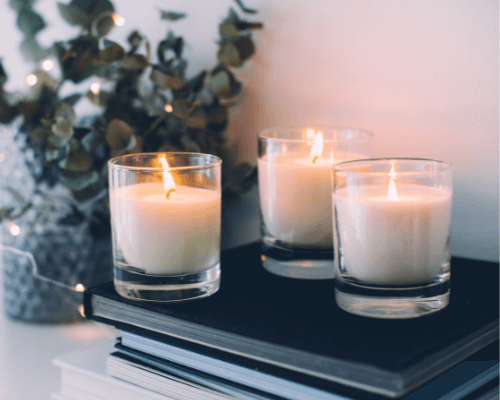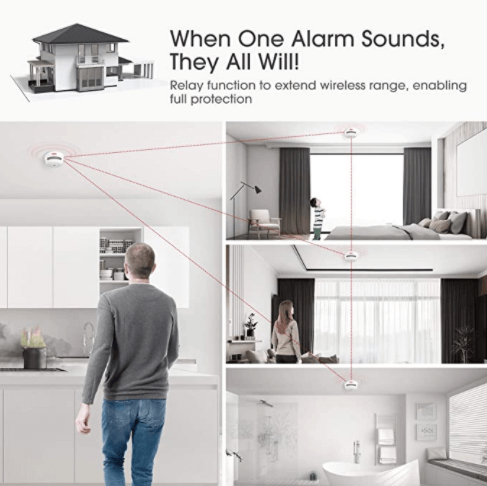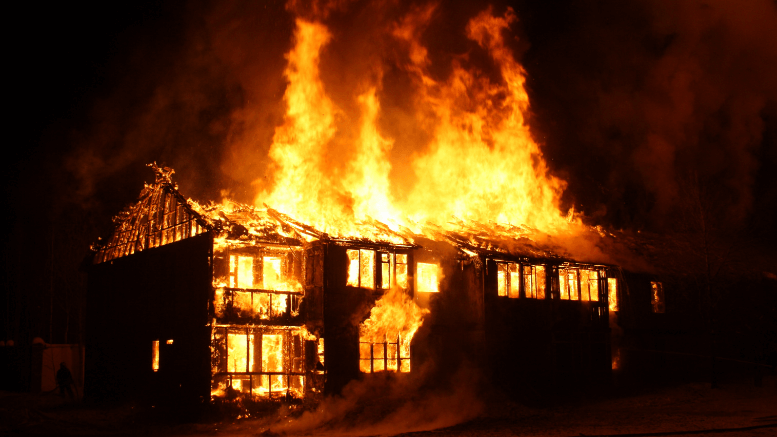Home fire safety again made the news today, with the devastating house fire that cost the lives of a mother, grandmother and two children. It’s an absolute tragedy that lives are continually lost in house fires in the United Kingdom every single year.
Whilst it is too early to understand what caused the fire and why they never managed to escape, nearly all deaths in house fires are entirely avoidable.
In this article, we’ll go through home fire safety with a fine toothcomb to reduce the risk of a fire in your home, and the steps you should take to give the best possible chance of escaping your house should a fire break out.
This is a comprehensive article. With that in mind, below is a table of contents. Clicking on any of these headings will jump you immediately to that piece of content.
Table of Contents
Home Fire Safety: The Definitive Guide
Here’s the Safe Secure Homes guide to home fire safety.
Please share this far and wide on social media, on email, and with friends, family and work colleagues – who knows, it could potentially save someones life one day.
What To Do If You Discover A Fire
If you discover a fire in your home, there’s just 3 simple things you will need to do:
- Get Out
- Stay Out.
- Dial 999.
Every fire service in the United Kingdom say this exact same thing. No saving the stamp collection. No saving the wedding album. No saving your favourite pair of shoes.
Get Out. Stay Out. Dial 999.
Doing these 3 things in this exact order will probably save your life.
It really is as simple as that.
Your Fire Escape Plan
A fire escape plan for you and your family could possibly save your life and your family’s life one day.

A fire escape plan should not be complicated. It should be a simple set of instructions, with every member of the household knowing exactly what they need to do in the event of a fire.
Think of fire escape plans you may have seen in hotels you have visited. Often, it will be on the back of your room door, with a simple diagram showing you where to go on discovering a fire or hearing the fire alarm.
Your home fire escape plan should be exactly like this. Whilst I’m not asking you to stick diagrams on the back of your doors, what I am saying is that you need this plan formulated in your mind and discussed as a household.
Your home fire escape plan should include details of:
- What is the quickest route to escape?
- What if the exit route is blocked by fire or smoke?
- Which upstairs windows lead to a flat roof that we can escape onto if our exit route is blocked?
- What if we have young children or people with disabilites, who will assist them?
Smoke Detectors & Heat Detectors
Smoke detectors and heat detectors are life saving pieces of equipment.
They are your early warning system, especially when you are asleep.
In my opinion, it should be law that every place of residence should have smoke detectors and heat detectors fitted throughout.
Remember, fires themselves aren’t the real killer, it’s the toxic smoke that is released which is the real killer.
Smoke and heat detectors are cheap and extremely easy to install.
Where To Place Smoke Detectors & Heat Detectors
The most important places for smoke and heat detectors in your home are:
- In your kitchen (a heat detector)
- In main living areas.
- Hallways.
- Landings.
- Loft.
Ideally, you should have a working smoke detector in every room in your home. This includes the loft and if you have one, in integrated garages (the ones that adoin your home).
Don’t forget: A really important area to place smoke detectors is in or near to sleeping areas, and along routes of escape (like hallways and landings).
Periodic Checks Of Smoke & Heat Detectors
A smoke detector that is broken or has run out of battery life is simply a peice of plastic hanging from your ceiling.
Alarmingly, it is claimed here that 38% of all smoke alarms in the UK will not alarm when fire is present due to flat batteries or no batteries.
Just imagine losing your family to a house fire, because you forgot to check your detectors were working.
It’s a horrific thought.
But did you know, there is actually a nationally defined day where you are encouraged to check the functionality of your detectors?
Nope, neither did I until I just Googled it. That’s how badly it’s advertised and marketed.
But if you get into the habit of checking your detectors on these days (twice a year, daylight saving day Sunday 27th March for clock forward, and again on Sunday 30th November for clocks back), at the same time when you’re changing the clocks, fridge clocks, cooker clocks, microwave clocks etc, then you are checking them twice a year for ultimate peace of mind.
It’s not just about checking them either.
If you know for a fact your smoke detector is a few years old, why not go ahead and do a battery replacement too?
In The Kitchen: Fire Safety
You should have a heat detector in your kitchen, not a smoke detector.
A smoke detector in a kitchen is a huge error trap. What usually happens is people think they are doing a good thing by installing a smoke detector in their kitchen.
Then they burn toast, something they are frying produces too much smoke, and the alarm continually goes off.
After the second or third time, people usually open it up and remove the battery.
It’s then forgotten about, and the batteries or an alternative are never sought, leaving the one place where 60% of all home fires start with no early warning system available.
This exact thing happened to my fathers neighbour, and I ended up installing a Fire Angel Heat Detector for under £10 in under 10 minutes.
As well as having a heat detector in your kitchen, there’s also other things you can do to reduce the risk of a fire occuring in your kitchen.
- Consider having a small fire extinguisher in your kitchen area.
- Consider having a fire blanket in your kitchen area.
- When using the oven, always use a timer so you don’t forget about food that is cooking.
- Never leave oven gloves or kitchen towel lying on the hob or on the oven door handle.
- Keep other items away from the hob when cooking.
- Keep matches and kitchen lighters out of reach of children.
- Never leave a frying pan unattended.
Fire Extinguishers & Fire Blankets
There’s two schools of thought about these fire safety devices in home settings.
The first school of thought is these products can put people in danger, because it gives a false sense of security and some fires can exceed the performance of the fire extinguisher – and skill of the user. In fact, some people have died because they have tried to put out a fire, especially with fire extinguishers.
The second school of thought is they are great safety devices because small fires can be dealt with quicker and can reuce the risk of a small, contained fire turning into a fire that burns an entire house down.

I’m lucky enough to have used both fire extinguishers and fire blankets in controlled training environments. I have both of these products in my kitchen at home, and I’m confident enough to use them. I also know the limitations of my skills, and know when to tackle a fire and when to get out.
Some people will lack in these skills and judgements, and will undoubtedly put themselves at more risk by owning them and having them in their kitchen.
So, it’s down to personal choice. If a fire broke out in your kitchen, or your frying pan went up in flames, would you be comfortable and have the presence of mind to calmly use a fire blanket or fire extinguisher?
You can read more on fire extinguishers and fire blankets in this excellent article here, as well as looking at the best kitchen fire extinguisher and fire blanket you can buy.
In The Lounge: Fire Safety
Smoking and candles were the biggest cause of fire in lounge or main living areas in the UK in 2020-2021.
Smoking in the home can cause fires in to main ways; falling asleep whilst smoking, and extinguishing smoking materials only for them not to be extinguished at all.
It is recommended that if you have to smoke, you make a habit of smoking outdoors. Not only will it drasticlly cut the risk of fire in your home, your home and all of the contents will smell frsh and clean, instead of being tainted with cigarette smoke.
Candles and the use of candles have slowly been on the rise over the years, mainly due to the emergence of candles as a way of scenting a home. Candles are the second cuase of fires in the lounge areas in the UK.
Below: note the sheer stupidity of placing candles on books!

If you have to use a candle with a live flame, consider the following:
- Use candles only in clear spaces, away from things like curtains, cushions and carpets.
- Never leave candle unattended.
- Use proper cande holders that won’t fall over. if the candle falls over, ensure that the holder will contain the candle.
- Never use candles at heights where children could potentially reach them.
- When blowing out a candle, mke sure you are still in the room for a period of time afterwards to ensure it doesn’t smoulder and reignite.
The best way to improve fire safety in your home is to use LED candles that are no fire risk at all.
In The Bedroom: Fire Safety
Smoking, candles and portable heaters were the main cause of fire in UK bedrooms in 2020-2021.
Falling asleep with any of these three left unattended is asking for trouble, yet people still do it under the impression that ‘it will never happen to me’.
The biggest safety measure is to avoid using all three of these in your bedroom before you go to sleep.
The next biggest safety measure is to have a smoke detector fitted inside the bedroom, which will alert you to fire or smoke in your immediate vicinity while you sleep.
- Swap out wax candles with battery operated, LED candles.
- Don’t smoke in the bedroom. Ideally, if you have to smoke, smoke outside.
- Use ceramic or oil filled portable heaters.
- Install a smoke detector in your bedroom.
In The Loft: Fire Safety
Fires in loft areas pose a very different type of danger than a fire anywhere else in your home.
A fire in the loft will most likely bring down your roof due to fire burning through any structural support beams for your roof.
It’s therefore absolutely essential to have a working heat detector or smoke detector in your loft.
But how would a fire start in the loft you might ask?
Well, in most lofts, you’ll have the wiring and circuits for the lights in your bedrooms, and although it’s uncommon for problems or fires to occur due to the general improved safety of consumer units and RCCB’s, it can still happen.
- Use a smoke or heat detector in the loft.
- Make sure insulation laid in your loft is fibre glass (non-flammable).
- Try not to ‘fire load’ i.e pilling flammable materials in the loft like cardboard boxes.
In The Garage/Shed: Fire Safety
Integral garages (garages attached to the main home dwelling) pose more of a threat than a detached garage or shed, for obvious reasons.
If you have an integral garage, it’s vital that you have either a heat detector or smoke detector located in their.
For garages that aren’t attached to your property, it’s wise to have a heat detector in there (smoke detectors can be set off with dust and damp, so avoid smoke detectors), although you are unlikely to hear it if you are far enough away from it or are asleep.
However, any fire in your garage is unlikely to pose an immeditae threat to life
Here’s some tips on how to minimise the chance of a fire occuring in your garage:
- Store chemicals away in cabinets or drawers, and away from any direct sunlight.
- When working with naked flames, ensure that you always work near an exit so you have an escape route.
- Use an integrated or linked detector for integral garages.
Consumer Unit/RCD: Fire Safety
A few years ago, I was awoken by the sound of sirens and blue flashing lights on my bedroom window.
It was maybe 2am or 3am in the morning.
The fire service were in the house opposite, dealing with a fire.
It didn’t concern me too much when I looked out of the window, I saw no smoke or flames, and everything appeared calm.
The next day I discovered it was an RCD fire (or fuse box fire). The owner of the house was alerted quickly due to him having working smoke detectors placed near to the fuse box, and the fire service were quickly on scene and the fire was contained in a small area under the stairs.
Wherever your fuse box is, place a smoke or heat detector near to it.
Vital Signs: Look Out For These Signs Of Potential Fire Risk
Fishy Smell
If you smell an unusual fishy smell anywhere in your home, act fast. A fishy smell is usually the sign that electrical compnents are burning.
The smell is cuased by chemicals and insulation materials in wires that are burning.
If you smell a fishy smell, it is vital that you find the source of the smell and isolate it (unplug or switch off), and call a qualified electrician immediately.
Scorch Marks/Black Marks On Plugs & Sockets
Again, this is anothe red flag, and can often be the sign of overheating, overloading or some sort of fault.
If you find a plug or socket in this condition, cease using it immediately and call a qualified electrician.
Electrical Items
Electricity and electrical products cause around 20,000 house fires a year.
Don’t become another statistic.
Tumble Dryers
Some tumble dryers are fire risks.
If your tumble dryer is more than a couple of years old, you should check the model number and serial number on the manufacturers website.
You’ll have heard a lot about tumble dryer fires over the past few years, but thankfully manufactures have been dealing with the issue for a number of years.
For your safety, if you have a tumble dryer, it is wise to note down the make, model and serial number, and check it against the manufacturers database in case their is a recall or notice on your particular model.
And don’t worry – this will be at no cost to you- manufacturers will come and either make modifications or give you a safer alternative. Just google your tumble dryer make and model.
Chargers
Always use official chargers from recognised manufacturers. Never ever be tempted to buy replacement chargers from places like eBay. These chargers sometimes don’t meet minimum safety standards, and are cheap for a reason.
Many use cheap, substandard components and are prone to overheating, faulting or causing fires.
E-Cigarettes & Vape Devices
Always be present when charging these vape devices.
They have been known to explode and cause fires, especially when charging and left unattended.
Buy ecigs and vapes from trusted retailers, and always use the charger supplied.
Sockets & Overloading
Don’t overload sockets with extensions and splitters.
If you haven’t got enough plug sockets and you think there’s a danger of overloading, get a qualified electrician in to install more.
Switch It Off
As I write this, electricity prices are at some of the highest levels ever seen.
If you are not using an electrical appliance, turn it off, and switch it off at the plug socket if you can.
Not only will you save money, you’ll be reducing the risk of fire.
Linked Smoke Detectors – A Great Idea
Linked smoke detectors are basically smoke detectors that go off in unison across your home when just one detects smoke.
If a fire breaks out in your conservatory, for example, and you are asleep in the bedroom at the front of your house, will you hear it? A lot depends on the size of your home, the thickeness of doors and walls, and even how deep you are in your sleep cycle.

None of that matters if you linked smoke detectors though. If the smoke detector inthe conservatory sounded, the smoke detector outside your bedroom would also alarm.
They are a superb innovation, and are thouroughly recommended (ideal especially for bigger homes).
Want to know more and which one to buy? Our article on linked smoke detectors and why you should have them will give you all the information you need.
Fire Safety vs Security
There’s a very fine line between keeping unwanted people out of your home, and exiting it safely in the event of a fire.
In this article here, for example, we talk about door jammers.
A door jammer is an excellent security device, but can also work against you in the event of a fire. An example of this is when you use a door jammer in the rails of a sliding patio door. Although you know there is a door jammer there, in the event of a fire and panic setting in, you might forget this, and on unlocking the patio door, you find that you can’y open the door because you’ve forgotten about the jammer.
Fire Safety And Children
Children are genrally taught at a young age in educational settings the dangers and risks posed by fire.
But don’t rely on educational settings.
Make it known to the child that fire is dangerous at every opportunity, and encourage them to watch childrenss programmes like Fireman Sam which has valuable lessons in fire safety all throughout each episode.
Summary
It was this news piece here that compelled me to write this article. I literally could not read the entire news article, and found myself choking up at the thought of the father seeing his wife, his mother in law and two children dying in front of his eyes.
Don’t become a story in a newspaper.
Here’s a quick summary of this article.
- Install smoke detectors and heat detectors in your home. The more the better.
- Install linked detectors as best practice.
- Agree a fire safety plan with your household, and make sure everyone knows what to do in the event of a fire.
- Consider having a fire blanket and fire extinguisher in your kitchen.
- Be ultra cautious when using things like candles.
- Electrical safety: be cautious using 3rd party plugs for electrical items, unplug when not needed.
- Know what signs to look out for; fishy smell, scorch marks.
My end advice is simple. Use a heat detector in your kitchen, and place cheap smoke detectors around your home, at a minimum of one per level. The more the better.
Recommended Fire Safety Products For Your Home
Here are two products that are absolutely essential purchases.
They are cheap to buy, and easy to install.
We are Amazon Associates, and make a commission on qualifying purchases.
- Heat Detector (Amazon)
- Smoke Detector (Amazon)
Here’s the links to all recommended fire safety products that you might like to consider purchasing.
- Fire Extinguisher – Small (Amazon)
- Fire Extinguisher – Large (Amazon)
- Fire Blanket (Amazon)
- Linked Smoke Detectors (Amazon)
Other Articles & Recommended Reading
Here are all of our other fire safety related articles:
- Your Home Fire Safety Plan
- Fire Angel Heat Detector Review
- Best Heat Detectors For kitchens (UK Top 3)
- Best Linked Smoke Detectors (UK Top 3)
- Do I Need A Fire Extinguisher At Home?
- Linked Smoke Detectors – Best Of
- Combination Smoke/Heat Detectors
Questions & Comments
If you have any questions or comments on the article above, please feel free to leave a comment in the section below.
If you found this article useful, please share it on social media or email a link to your friends, family and work colleagues.
Stay Safe. Stay Secure.



How do i get a home check,our smoke alarm has busted and we are both over 75 and one disabled.
Hi, depending on the county you live in the criteriais different.
Try this article: https://www.safesecurehomes.co.uk/free-smoke-detector-from-the-fire-service/ find the county and then click the link which will tell you what the criteria is.
Alternatively, use Google to find your local fire service and ring them – simply ask for free smaoke alarms and home checks, and they’ll get you sorted.
hi i am deaf so cant ring–would like home check—my fire alarm is not working–think maybe battery caput??ply fire service fitted it around 2016–haveing job to get a btt-the system is wi-safe2 fireangel–mains with btt back up===yellow light was flashing now nothing–was going to try new btt but cant get one–worrying because did have fire in 2015? hope you can help? only contact me on email—DEAF pete
Hi Pete, I have emailed you. Thanks.